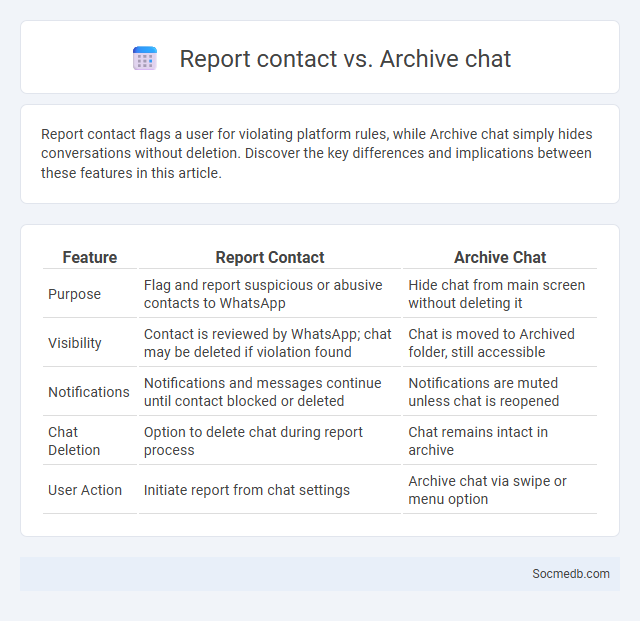
Photo illustration: Report contact vs Archive chat
Report contact flags a user for violating platform rules, while Archive chat simply hides conversations without deletion. Discover the key differences and implications between these features in this article.
Table of Comparison
| Feature | Report Contact | Archive Chat |
|---|---|---|
| Purpose | Flag and report suspicious or abusive contacts to WhatsApp | Hide chat from main screen without deleting it |
| Visibility | Contact is reviewed by WhatsApp; chat may be deleted if violation found | Chat is moved to Archived folder, still accessible |
| Notifications | Notifications and messages continue until contact blocked or deleted | Notifications are muted unless chat is reopened |
| Chat Deletion | Option to delete chat during report process | Chat remains intact in archive |
| User Action | Initiate report from chat settings | Archive chat via swipe or menu option |
Understanding Report Contact, Archive Chat, and Block Contact
Understanding how to report contacts on social media platforms helps maintain a safer online environment by allowing users to flag inappropriate or harmful behavior efficiently. Archiving chat functions enable users to organize conversations without deleting important messages, preserving access to past interactions while reducing clutter. Blocking contacts prevents unwanted communication and enhances privacy by restricting the blocked individual's ability to view profiles or send messages, contributing to a controlled and secure digital experience.
Key Differences Between Report, Archive, and Block Features
The key differences between report, archive, and block features on social media revolve around user control and content management: reporting flags inappropriate or harmful content to platform moderators for review, archiving allows you to hide posts from your profile without deletion, preserving personal memories privately, and blocking restricts interactions by preventing specific users from viewing your profile or contacting you. Understanding these distinct functions is essential for maintaining your online safety and managing your digital footprint effectively. Each feature serves a unique purpose in enhancing your social media experience and protecting your privacy.
When to Use the Report Contact Option
Use the Report Contact option on social media platforms when encountering harassment, spam, or suspicious behavior violating community guidelines. It is crucial to report contacts engaging in hate speech, threats, or impersonation to maintain a safe digital environment. Social media networks such as Facebook, Instagram, and Twitter prioritize these reports to ensure user security and platform integrity.
How Archiving a Chat Works and Its Benefits
Archiving a chat effectively removes the conversation from the main chat list without deleting it, allowing users to declutter their interface while preserving message history. This feature enables easy retrieval of archived chats through search functions, ensuring important data remains accessible when needed. By securely storing past conversations, archiving supports better organization and enhances user privacy by minimizing active chat visibility.
Steps to Report a Contact Effectively
To report a contact effectively on social media, start by locating the user's profile or the specific content that violates platform guidelines. Use the platform's built-in reporting tools, selecting the most accurate category that describes the issue, such as harassment, spam, or inappropriate content to ensure your report is directed correctly. Follow prompts to provide detailed evidence or descriptions to support your report, increasing the chance of timely and appropriate action from the platform.
Privacy and Security Implications of Reporting vs Archiving
Reporting on social media often involves exposing user-generated content for moderation or legal review, which raises significant privacy concerns as sensitive data may be accessed by third parties. Archiving social media content, on the other hand, focuses on preserving historical records but demands robust security measures to prevent unauthorized access or data breaches. Both practices require stringent compliance with data protection regulations like GDPR and CCPA to safeguard user privacy while ensuring accountability.
Common Scenarios for Archiving Chats
Common scenarios for archiving chats on social media include preserving important conversations for legal compliance, maintaining records for customer service interactions, and saving personal memories or significant exchanges. Archiving ensures data security and easy retrieval in case of audits, disputes, or future reference. Platforms like Facebook Messenger, WhatsApp, and Slack offer built-in features to archive chats efficiently, supporting organizational and individual needs.
User Experience: Archived Chats vs Reported Contacts
User experience on social media platforms varies significantly between managing archived chats and reported contacts, with archived chats providing seamless access to past conversations for easy retrieval and organization. In contrast, reported contacts involve a critical interface designed for users to flag inappropriate behavior swiftly, ensuring platform safety through efficient moderation tools. Enhanced user interfaces and backend algorithms prioritize privacy and responsiveness, optimizing both archived chat accessibility and the handling of reported contacts to maintain trust and engagement.
Limitations and Risks of Each Feature
Social media platforms often face limitations such as algorithmic bias affecting content visibility and user engagement metrics that can skew perceptions of popularity. Risks include privacy breaches through data sharing features, misinformation spread via viral sharing capabilities, and mental health impacts linked to excessive use of likes and comments. Each feature, while enhancing connectivity, introduces vulnerabilities like cyberbullying in comment sections and echo chambers stemming from personalized feed algorithms.
Best Practices for Managing Unwanted Chats
Effective management of unwanted chats on social media requires the implementation of strict privacy settings and the use of platform-specific blocking or muting features to prevent further contact. Regular monitoring of message requests and reporting suspicious or abusive behavior to platform moderators helps maintain a safe communication environment. Employing automated filters and keyword controls can further reduce exposure to spam and inappropriate content.
 socmedb.com
socmedb.com